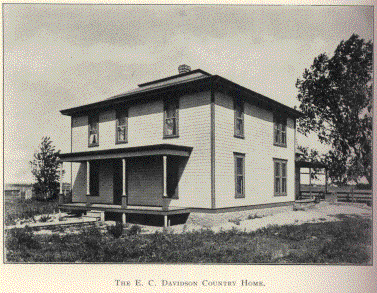E.C. Davidson, the subject of this sketch, has gained a record in the Solomon valley for the perserverance, pluck and courage with which he bore the hardships incident to building a home on the frontier. But the spirit which led him to the new West served him through a long seige of toil, disappointments, failures, drouths and grasshoppers. Though not the first to pitch his tent in the undeveloped country, E.C. Davidson was early on the ground, and his lands to-day bear little resemblance to the government claim he secured in 1869.

THE E.C. DAVIDSON COUNTRY HOME.
The handsome and commodious residence has long since been substituted for the dugout or cabin of primitive days. His herds of fine bred cattle have supplanted the horned Texas steer and the poorly constructed stables have given way to the immense bank barn that is filled to the rafters with the sweet scented alfalfa and golden grain. In fact, everything has been transformed from a mere prairie claim to a well tilled and improved farm.
E.C. Davidson is a native of Franklin County, Ohio, born in 1847. When sixteen years of age he came with his brother, Garrett, to Illinois, and settled on a farm near Bushnell, where he lived seven years. In 1869, he came to Kansas and rented land in Washington county for one year, in the meantime coming to Cloud and selecting a homestead, his present country place.
He was married in 1870, to Anna Franks, whose parents were early settlers in Kansas. Mr. Davidson started in life with practically none of this world's goods, but he secured a wife who has very materially assisted in gaining the competency they now enjoy. She shared nobly the trying ordeals of the early settlers' wives and is his better half in the truest sense of the word. They adapted themselves to circumstances, and their little cabin was polished with content, happy in their dreams of the future. While their larder was sometimes lacking in variety, there was never a scarcity of meat.
Mr. Davidson was a typical frontiersman, fond of the hunt, and his trusty rifle has been the means of bringing about many a repast fit for the gods. Buffalo and antelope were plentiful, with droves of wild turkeys and flocks of prairie chicken and quail. He brought in game by the wagon load. He was also fond of the chase and retains a special weakness in this direction, keeping a kennel of dogs for this pastime. He has quite an interesting collection of coyote, fox and jackrabbit trophies.
However, he is a thorough agriculturist, taking great pride in his crops of wheat and alfalfa. This year (1901) he has two hundred tons of hay in his barn. The yield from this alfalfa ground netted him $50 per acre. He has been feeding and shipping cattle for more than fifteen years, which was the beginning of his prosperity. He is a Short Horn breeder and has one hundred and fifty head of fine cattle. He has just completed one of the most perfectly planned feeding barns in this or any other country. Its dimensions are 43x64 feet, with a basement. He constructed another large barn 64x64 feet, in 1889.
To Mr. Davidson belongs the distinction of hauling the first building material that went into the present town of Beloit, which is in all probability a bit of hitherto unwritten history. When making his second trip from Washington county to the Solomon valley, he was accosted by a citizen of Abilene, who asked his destination. Upon being told it was Glasco, he said he had some lumber he wanted hauled to Willow Springs, (now Beloit) and offered five dollars for the transportation of it to that place. This was May 5, 1870, and the lumber was for a Mr. Elliott, who built the first shanty on the town site.
Mr. Davidson relates many interesting reminisences of pioneer times, buffalo hunts, etc., some of them appearing elsewhere on these pages. It was several years before the Davidsons' began to prosper or even possessed a cow. The new comers were handicapped in so many ways they could not progress rapidly. Again, after raising the grain there was no market nearer than Clay Center. He says on one occasion he hauled a load of rye to that town, which required three days time, receiving but twenty-five cents per bushel.
He has always raised hogs and got his start in this industry by delivering fourteen bushels of corn to Matt Wilcox in exchange for two Chester White pigs. It took Mr. Davidson a dozen years or more to put his land under cultivation. His efforts were retarded because he did not have sufficient teams or grain to feed them.
Mr. and Mrs. Davidson have an interesting family of three sons and one daughter, who are all useful members of society, viz: William (see sketch), Lorean, (see sketch); Retta, the only daughter is an accomplished young lady. She is a student of Lindsborg College, where she is taking a special course in music. She is a graduate of the Glasco high school and on her third year of the college course. Joseph N. graduated from the Glasco high school and is a law student in the Kansas State University.
Mr. Davidson is a Democrat in politics and is a member of the order of I.O.O.F., of Glasco lodge.
![]()
Transcribed from E.F. Hollibaugh's Biographical history of Cloud County, Kansas biographies of representative citizens. Illustrated with portraits of prominent people, cuts of homes, stock, etc. [n.p., 1903] 919p. illus., ports. 28 cm.
